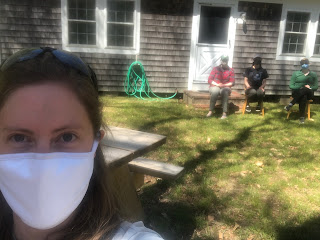Ankommen (Arrival)
There's this spot on the B deck where everything is quiet. There's a grate that vents warm air from somewhere inside the ship. There are no whirring fans, and it's protected from the wind. I can see out over the blue-gray water all the way to the clouded horizon. It's like this little protected bubble. On the lower decks, there are engineers drilling holes, clacking on keyboards, and making hydrophones chirp. There are crew members hauling ladders around and stringing cables. The helicopter pilots are preparing for their daily flight. It's Richard Scary's Busytown down there, and by contrast, my little spot feels darn close to a sensory deprivation chamber. It's nice. We crossed a line sometime yesterday, and the air turned dry and cold. The waves have dampened, and the sun is hidden by a canopy of gray felt. It all feels eminently familiar, if only I take the time to notice. Less than 24 hours remain until we reach our first sampling station, and I am s
